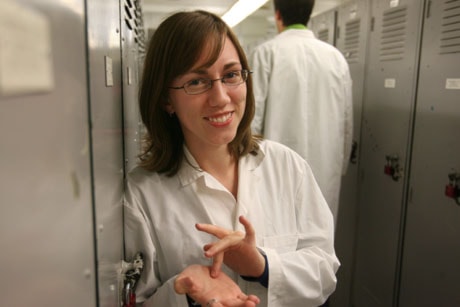WINNIPEG — Megan Jack hoists a hefty black backpack over her petite frame and carries it like a pro.
The first-year University of Manitoba medical student is like most other aspiring doctors. She lugs textbooks around. She survives marathon study sessions. And she attends classes all day.
But during lectures — while other students concentrate on the professor’s words — Jack, 23, focuses on two figures positioned at a podium in the front of the classroom.
They are interpreters who speak to Jack with their hands, translating into sign language everything her professor says.
The interpreters are there specifically for Jack, who is completely deaf and communicates using American Sign Language (ASL).
Jack is the first deaf student in the history of the U of M’s MD program.
Jack, a modest young woman, blushes, smiles and tilts her head down when it’s suggested that she is a pioneer of sorts.
“Well, not really, but thank you,” she says during an interview through two interpreters at the U of M’s Bannatyne campus.
If she completes medical school, Jack will be one of the first completely deaf medical doctors in Canada, says Dr. Bruce Martin, associate dean of the U of M’s faculty of medicine. (Official statistics about deaf medical doctors in North America do not exist, though there are more in the United States than in Canada.)
Jack, who grew up in Altona, Man., and can’t ever remember hearing, says that she’s wanted to be a physician since she was a kid. She looks forward to taking care of patients who are deaf so they can finally have a doctor they can “communicate directly with.”
While critics may question how hearing patients will react to having a doctor who can’t hear, Jack doesn’t seem to worry about that.
“Obviously, I haven’t tried this yet,” says the student, who loves reading, travelling and in-line skating. “I think that for the most part people will accept me for the way I am. Obviously it might be a little awkward at first.
“That’s often what happens. And I’ll say to them, ‘You know, I’m not going to bite you or anything.”’
She realizes that there will be complications to becoming a deaf doctor. She will need to use a stethoscope with a visual output to detect a patient’s heart rate. Clinical training in an emergency-room situation that requires a keen sense of sound will be tricky. ASL doesn’t have words for most medical terms, so her interpreters must spell them for her during class.
The U of M currently covers the costs of Jack’s three part-time interpreters, with the help of provincial grants. While other practising deaf doctors use ASL interpreters (often paid for by their employers), Jack hopes to avoid the need for an interpreter when she goes into practice.
“There’s a shortage of interpreters here in Winnipeg and across Canada, so I don’t want to be partly responsible for the shortage,” she says.
Jack says her determination is a result of her upbringing. Around the house, her mother and father treated her as “normally” as her two brothers, who can both hear. Her parents made sure she was never behind in class and provided her with speech therapy and extra lessons.
Jack’s parents didn’t always know she was deaf. They suspected something was wrong at a young age when she wasn’t responding to her name and her vocabulary wasn’t at the level it should be.
After years of visits to specialists, she was finally diagnosed at age four with “profound to severe” hearing loss. The cause was unknown but due to nerve damage, says Jack’s mother, Kathryn, who still lives in Altona, 115 kilometres south of Winnipeg, with her husband and Jack’s father, Brian.
Kathryn recalls anticipating that once Megan began kindergarten that she and her husband would need to do everything they could to help their daughter stay ahead.
“In Grade 3 she was working on Grade 5 English,” says Kathryn. “By the time she reached junior high she was doing pretty well and she was going to do well regardless.”
Jack says growing up in a small town with people who knew her from childhood was comforting. Many of her friends, she says, know ASL. She can communicate with the ones who don’t through lip reading, text messaging and email. She uses her voice with close friends and family.
Jack, who has a four-year bachelor’s degree in biology from the U of M, admits that moving to Winnipeg away from her family was a big transition. Now, she loves it and is touched by many of her medical school peers, who voluntarily take an ASL course recently introduced to her faculty.
Do people have misconceptions about her?
“I guess sometimes they think that they have to speak really loud,” says Jack, who wears a hearing aid to help her detect significant noises though she cannot make out words and specific sounds.
“They think that would help. But of course, that doesn’t help me at all.”
